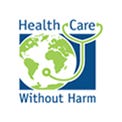Federal leaders & private health systems discuss turning climate commitments into action at CleanMed
Last month, more than 700 health care professionals from across the United States gathered at Health Care Without Harm and Practice Greenhealth’s annual CleanMed conference in Pittsburgh.
One of the conference highlights was a session moderated by Health Care Without Harm senior advisor Kathy Gerwig, where leaders from the federal Office of Climate Change and Health Equity, The Joint Commission, and Providence discussed the momentum building around health care sector climate action and what it takes to act on bold commitments to climate change mitigation and resilience.
Hospitals and health systems are increasingly committing to ambitious climate goals. More than 100 organizations representing almost 900 hospitals, including members of our Health Care Climate Council and the Practice Greenhealth network, have signed the White House-U.S. Department of Health and Human Services (HHS) Health Sector Climate Pledge, committing to reducing greenhouse gas (GHG) emissions, designating an executive-level lead for their work on reducing emissions, and establishing climate resilience plans.
How can health care organizations turn these bold goals and commitments into action?
Dr. John Balbus, acting director of the federal Office of Climate Change and Health Equity, shared how his office is helping hospitals and health systems tackle climate change. This includes:
- getting climate change expressly written into the HHS strategic plan and the national health security strategy,
- establishing a federal health systems learning network as a community of practice to catalyze decarbonization inside the federal government, and
- launching a health sector resource hub with information on programs and supports to help health care invest in emissions reduction and resilience.
Although there is increasing momentum for health care climate action, it is not currently meeting the demands the climate crisis calls for according to Balbus, “We’ve got great momentum with the [Health Sector Climate] Pledge, but we’re still at about 15% of the nation’s health sector covered, and we need to get that much higher to get to the tipping point for transformation.”
When asked how to get more health systems on board, Balbus shared, “There is widespread perception that what we’re asking for is going to be hard, expensive, and onerous. What we have to do is show people just how fun and easy the start of the road is, and what cost savings can be achieved. We have to meet people where they are, understand their perception of the barriers, and appeal to common values whether that’s health equity, service to community, service to a higher power, or service to the planet. We need to make it easy to get started.”
According to Beth Schenk, associate vice president of environmental stewardship at Providence, sharing success stories of sustainability efforts can attract more health care organizations to join the movement for climate action.
“We should continue to highlight the positive and talk about the value proposition, which is all the things that we do from reputation to recruitment to retention to cost savings to safety to meeting regulatory requirements to bringing joy to workers to bring joy to ourselves to really meeting our needs and demands, because we know what we’re up against in terms of the climate crisis, and we know what we’re up against in terms of harm,” Schenk shared.
Kathryn Petrovic, director of The Joint Commission’s Department of Standards and Survey Methods, shared updates about new standards to advance environmental sustainability for the hospital and critical access hospital programs.
“We’re looking at creating a voluntary program and evaluating how best to do that,” Petrovic said. “So we can recognize those organizations that are really doing a stellar job within the framework we’ve developed.” One of The Joint Commission’s goals, she shared, is to make a resource center for health care organizations available later this year.
The Joint Commission’s new, dedicated health care equity standards, which became effective last January, are now integrated into its hospital, ambulatory health care, and behavioral health care and human services accreditation programs.
The panelists shared their perspectives on opportunities for collective action such as the recent joint effort of Health Care Climate Council members and other health sector leaders to encourage the Centers for Medicare and Medicaid Services (CMS) to issue a Categorical Waiver for health care microgrid systems, allowing health systems to use clean energy microgrid systems for emergency power generation instead of relying on fossil fuel-powered sources.
They also discussed tools, resources, and guidance to help health care organizations measure and track their GHG emissions.
Our Health Care Emissions Impact Calculator, an accounting tool specifically designed to help health care organizations measure their GHG emissions, is the first free, publicly available tool of its kind.
This calculator can benefit all health care organizations, whether you are just embarking on the path toward climate-smart health care or are already on your way. It was developed following the GHG Protocol and can be used to develop a GHG inventory for all scope 1, 2, and 3 emissions at the facility or system level.
As she reflected on the partnerships highlighted at CleanMed, Schenk expressed her optimism for the future, “[My hope is] that we’re able to realize and mobilize the clinical voice, and I mean that for clinicians and also for the health care sector at large, because what are we about if not protecting health? From my perspective, I feel like it’s coming together with more clarity and more alignment and therefore it’s coming together with effectiveness. I can’t express enough how exciting this is for someone who has been doing this in the field for many years to see this kind of alignment and support.”
